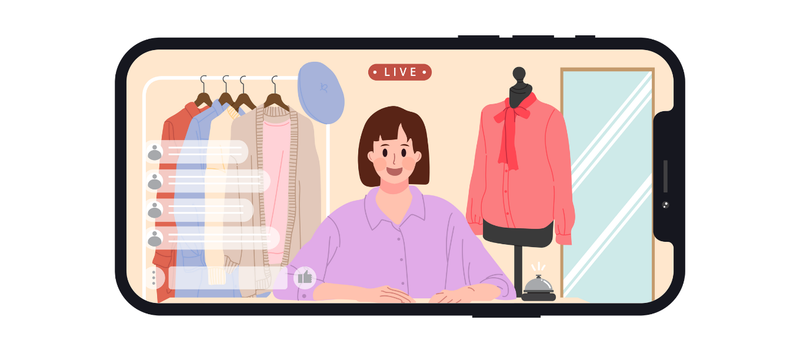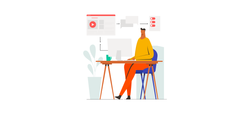Recent trends indicate that Live Shopping is a technology worth exploring. In fact, live shopping generated $60 billion in global sales in 2019, according to Coresight. To determine if this trend is worth integrating with your current sales strategies, let’s take a deep dive into live shopping.
What is Live Shopping?
In some capacity, Live Shopping has always existed since the dawn of technology like radio, telephone, and television. Before Live Shopping, there were television channels on which customers could call-in purchases as they were watching demonstrations of available products. These channels are still around today, but do not retain the popularity they once had. Now, in 2023, it’s worth exploring how these older traditions have modernized.
While the essence remains the same, the concept has shifted to platforms like Instagam and YouTube. Many vendors have been able to gain rapid growth and massive revenue from hosting these types of events.
Is Live Shopping the Future of E-Commerce?
Some thinkers believe that live shopping will dramatically change the future of e-commerce, but there are some that believe otherwise. Live Shopping can increase one’s sales, sure; however, you must make your presence known on all platforms before launching a Live Shopping campaign in order to drive impactful results.
Live Shopping is not the future of e-commerce, per se. Rather, it is a tool that will bring you more sales if executed well. Let’s dig in to some of the basics below.
What are the Basics of Live Shopping?
Live Shopping offers a variety of benefits for anyone interested in using it. With a basic understanding of the technologies involved, any organization can get started with Live Shopping. Let’s take a look at some of the fundamentals below.
To create a Live Shopping session, you’ll need a few things:
-
A product or service to sell
-
A host or presenter
-
A platform to host the session on
-
An audience
You may also need to research which products will offer you the best results during a Live Shopping session. There are a few questions to ask yourself, such as:
-
Do I want to collect feedback on an item?
-
Do I want to promote an underperforming item?
-
Do I want to debut a new item?
-
Do I want to drive more sales for my best-selling items?
Asking yourself these questions can help you determine which products or services you will have the most success with while hosting a live shopping session.
Regarding your host, you may want to have someone who understands the product well enough to showcase it in a positive light and demonstrate all relevant features to your audience.
You could also explore avenues such as influencer marketing in order to bring more of a loyal following to your live shopping experience.
Finally, remember that live shopping is live. There will be no editing or retakes during the production of the event, so rehearsal may be necessary if you are planning a long, complex live shopping experience. It’s important to determine a structure for your program so that your audience understands what to expect.
Overall, live shopping can bring interactivity, spontaneity, and excitement for your viewers if done correctly. There is no one way to do live shopping, but there are goals that you can outline and determine how to reach them with your event.
6 Tips for Leveraging Live Shopping
Here are a few tips for getting the most out of a Live Shopping experience. Simply because you build a live shopping event does not mean that you will see benefits immediately. As with any new tactic, there is value in researching and understanding how to integrate it with your current strategies.
Understand Your Target Audience
If you don’t know your audience, you won’t be able to lead a successful live shopping session. Use your previous research on your target audience to determine the following:
-
Which products to promote
-
Which platforms to choose
-
Who should host the event
-
When you should host it
-
How you should promote it
-
What content you should create
If you’re stuck on gaining insights about your audience, use audience or buyer personas to discover more about your customers and potential buyers.
Build a Following
Live Shopping works best when you already have an engaged audience that is enthusiastic about your products and your product development. Your goal shouldn’t be to have a large following for just this one live shopping event, but rather to create a community that attends and participates in all your events!
Embracing consistency across your brand in how you promote and organize your events and speak with your customers will encourage further presence in your live shopping events.
Create Great Content
If you’re not used to creating content for your buyers, there are many ways to get started. These practices can help customers know what to expect when you release a live shopping session. Make sure to create content leading up to and after the event to be extremely high-touch during the entire process.
During the live shopping event, however, you will need to decide on what type of content or what type of session you will want to host. There are a few options available, such as:
-
Q&A Sessions: Allow your audience to ask questions, building more trust
-
Product Releases: If your viewers are first to know about a specific product, they will feel like they are a part of your organization, and therefore deepen their loyalty
-
Product Tutorial: If you’ve seen people asking specific questions about specific products, these sessions can act as training or help sessions that get potential buyers to understand your products even better
Deciding on the right format is always up to the business owner, but a combination of these three options will allow consumers to feel personally connected to your host and your brand.
Market Your Live Shopping Events
At a live event, you don’t want to present just yourself and your products! Without a proper audience, there is no reason to host a live shopping event. Make sure your audience knows when and where your live event will be. Here are a few marketing tips to ensure you get the most out of your session.
-
Share on Social: Create buzz across all your channels for your live event
-
Run Social Ads: If you have budget for ads, create compelling ads that drive sign-ups for the event
-
Incentivize Viewers: If your viewers don’t have a reason to join, chances are they will not. Offering a raffle or a giveaway could get you more sign ups for your live event
Use Directed Calls-to-Action
In a live shopping event, you must remind your audience to buy. You don’t want to wait until the end of the stream to promote actions like buying or adding to cart. Remind viewers to purchase at regular intervals.
Doing so for the first time may feel awkward, but we have researched a few key places for calls-to-action during your live shopping event.
-
At the beginning of the event
-
During breaks, such as after answering a question
-
Whenever you hit a sales goal, such as 25, 50, or 75 items sold
-
Right before ending the event
The goal with live shopping is to toe the line between commercial and information/interaction with your audience. If done successfully, you will see orders roll in!
Choose the Best Platform
The right platform can make all the difference in live shopping. Be sure to research your country’s regulations and accessibility of platforms. For instance, live shopping on Instagram at the time of publication is still only available in the United States.
Take the five learnings from this article, and combine them to determine the right platform for you. There are many platforms that offer dedicated live shopping integrations, but these platforms may not work for you and your audience.
Start Live Shopping Today
Live shopping bridges the gap between traditional in-person shopping and online shopping, offering sellers the ability to market their products and customers to purchase in real time. It offers human connection and personal touches that were not previously available in traditional e-commerce.
Customers can enjoy the convenience of shopping from anywhere, while retailers are presented with new audiences and customers, getting the chance to grow their sales.
To get started, follow the tips in this article, and start leveraging live shopping today!




